I am having this error when seeding my database with code first approach.
Validation failed for one or more entities. See 'EntityValidationErrors' property for more details.
To be honest I don't know how to check the content of the validation errors. Visual Studio shows me that it's an array with 8 objects, so 8 validation errors.
This was working with my previous model, but I made a few changes that I explain below:
- I had an enum called Status, I changed it to a class called Status
- I changed the class ApplicantsPositionHistory to have 2 foreign key to the same table
Excuse me for the long code, but I have to paste it all. The exception is thrown in the last line of the following code.
namespace Data.Model
{
public class Position
{
[DatabaseGenerated(System.ComponentModel.DataAnnotations.DatabaseGeneratedOption.Identity)]
public int PositionID { get; set; }
[Required(ErrorMessage = "Position name is required.")]
[StringLength(20, MinimumLength = 3, ErrorMessage = "Name should not be longer than 20 characters.")]
[Display(Name = "Position name")]
public string name { get; set; }
[Required(ErrorMessage = "Number of years is required")]
[Display(Name = "Number of years")]
public int yearsExperienceRequired { get; set; }
public virtual ICollection<ApplicantPosition> applicantPosition { get; set; }
}
public class Applicant
{
[DatabaseGenerated(System.ComponentModel.DataAnnotations.DatabaseGeneratedOption.Identity)]
public int ApplicantID { get; set; }
[Required(ErrorMessage = "Name is required")]
[StringLength(20, MinimumLength = 3, ErrorMessage="Name should not be longer than 20 characters.")]
[Display(Name = "First and LastName")]
public string name { get; set; }
[Required(ErrorMessage = "Telephone number is required")]
[StringLength(10, MinimumLength = 3, ErrorMessage = "Telephone should not be longer than 20 characters.")]
[Display(Name = "Telephone Number")]
public string telephone { get; set; }
[Required(ErrorMessage = "Skype username is required")]
[StringLength(10, MinimumLength = 3, ErrorMessage = "Skype user should not be longer than 20 characters.")]
[Display(Name = "Skype Username")]
public string skypeuser { get; set; }
public byte[] photo { get; set; }
public virtual ICollection<ApplicantPosition> applicantPosition { get; set; }
}
public class ApplicantPosition
{
[Key]
[Column("ApplicantID", Order = 0)]
public int ApplicantID { get; set; }
[Key]
[Column("PositionID", Order = 1)]
public int PositionID { get; set; }
public virtual Position Position { get; set; }
public virtual Applicant Applicant { get; set; }
[Required(ErrorMessage = "Applied date is required")]
[DisplayFormat(DataFormatString = "{0:d}", ApplyFormatInEditMode = true)]
[Display(Name = "Date applied")]
public DateTime appliedDate { get; set; }
[Column("StatusID", Order = 0)]
public int StatusID { get; set; }
public Status CurrentStatus { get; set; }
//[NotMapped]
//public int numberOfApplicantsApplied
//{
// get
// {
// int query =
// (from ap in Position
// where ap.Status == (int)Status.Applied
// select ap
// ).Count();
// return query;
// }
//}
}
public class Address
{
[StringLength(20, MinimumLength = 3, ErrorMessage = "Country should not be longer than 20 characters.")]
public string Country { get; set; }
[StringLength(20, MinimumLength = 3, ErrorMessage = "City should not be longer than 20 characters.")]
public string City { get; set; }
[StringLength(50, MinimumLength = 3, ErrorMessage = "Address should not be longer than 50 characters.")]
[Display(Name = "Address Line 1")]
public string AddressLine1 { get; set; }
[Display(Name = "Address Line 2")]
public string AddressLine2 { get; set; }
}
public class ApplicationPositionHistory
{
[DatabaseGenerated(System.ComponentModel.DataAnnotations.DatabaseGeneratedOption.Identity)]
public int ApplicationPositionHistoryID { get; set; }
public ApplicantPosition applicantPosition { get; set; }
[Column("oldStatusID")]
public int oldStatusID { get; set; }
[Column("newStatusID")]
public int newStatusID { get; set; }
public Status oldStatus { get; set; }
public Status newStatus { get; set; }
[StringLength(500, MinimumLength = 3, ErrorMessage = "Comments should not be longer than 500 characters.")]
[Display(Name = "Comments")]
public string comments { get; set; }
[DisplayFormat(DataFormatString = "{0:d}", ApplyFormatInEditMode = true)]
[Display(Name = "Date")]
public DateTime dateModified { get; set; }
}
public class Status
{
[DatabaseGenerated(System.ComponentModel.DataAnnotations.DatabaseGeneratedOption.Identity)]
public int StatusID { get; set; }
[StringLength(20, MinimumLength = 3, ErrorMessage = "Status should not be longer than 20 characters.")]
[Display(Name = "Status")]
public string status { get; set; }
}
}
using System;
using System.Collections.Generic;
using System.Linq;
using System.Text;
using System.Data.Entity;
using System.IO;
namespace Data.Model
{
public class HRContextInitializer : DropCreateDatabaseAlways<HRContext>
{
protected override void Seed(HRContext context)
{
#region Status
Status applied = new Status() { status = "Applied" };
Status reviewedByHR = new Status() { status = "Reviewed By HR" };
Status approvedByHR = new Status() { status = "Approved by HR" };
Status rejectedByHR = new Status() { status = "Rejected by HR" };
Status assignedToTechnicalDepartment = new Status() { status = "Assigned to Technical Department" };
Status approvedByTechnicalDepartment = new Status() { status = "Approved by Technical Department" };
Status rejectedByTechnicalDepartment = new Status() { status = "Rejected by Technical Department" };
Status assignedToGeneralManager = new Status() { status = "Assigned to General Manager" };
Status approvedByGeneralManager = new Status() { status = "Approved by General Manager" };
Status rejectedByGeneralManager = new Status() { status = "Rejected by General Manager" };
context.Status.Add(applied);
context.Status.Add(reviewedByHR);
context.Status.Add(approvedByHR);
context.Status.Add(rejectedByHR);
context.Status.Add(assignedToTechnicalDepartment);
context.Status.Add(approvedByTechnicalDepartment);
context.Status.Add(rejectedByTechnicalDepartment);
context.Status.Add(assignedToGeneralManager);
context.Status.Add(approvedByGeneralManager);
context.Status.Add(rejectedByGeneralManager);
#endregion
#region Position
Position netdeveloper = new Position() { name = ".net developer", yearsExperienceRequired = 5 };
Position javadeveloper = new Position() { name = "java developer", yearsExperienceRequired = 5 };
context.Positions.Add(netdeveloper);
context.Positions.Add(javadeveloper);
#endregion
#region Applicants
Applicant luis = new Applicant()
{
name = "Luis",
skypeuser = "le.valencia",
telephone = "0491732825",
photo = File.ReadAllBytes(@"C:\Users\LUIS.SIMBIOS\Documents\Visual Studio 2010\Projects\SlnHR\HRRazorForms\Content\pictures\1.jpg")
};
Applicant john = new Applicant()
{
name = "John",
skypeuser = "jo.valencia",
telephone = "3435343543",
photo = File.ReadAllBytes(@"C:\Users\LUIS.SIMBIOS\Documents\Visual Studio 2010\Projects\SlnHR\HRRazorForms\Content\pictures\2.jpg")
};
context.Applicants.Add(luis);
context.Applicants.Add(john);
#endregion
#region ApplicantsPositions
ApplicantPosition appicantposition = new ApplicantPosition()
{
Applicant = luis,
Position = netdeveloper,
appliedDate = DateTime.Today,
StatusID = 1
};
ApplicantPosition appicantposition2 = new ApplicantPosition()
{
Applicant = john,
Position = javadeveloper,
appliedDate = DateTime.Today,
StatusID = 1
};
context.ApplicantsPositions.Add(appicantposition);
context.ApplicantsPositions.Add(appicantposition2);
#endregion
context.SaveChanges(); --->> Error here
}
}
}



